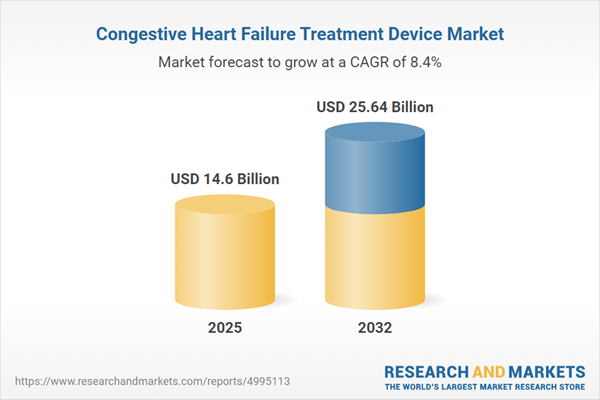Speak directly to the analyst to clarify any post sales queries you may have.
Senior leaders in the congestive heart failure treatment device market face a complex landscape shaped by rapid technological advancement, shifting care delivery models, and evolving regulatory frameworks. Strategic agility and informed decision-making are essential for maintaining a resilient market position while balancing operational risks and emerging opportunities.
Market Snapshot: Congestive Heart Failure Treatment Device Market Overview
The congestive heart failure treatment device market is currently valued at USD 13.44 billion in 2024, with projections rising to USD 14.60 billion in 2025 and reaching USD 25.64 billion by 2032. This growth trajectory is propelled by ongoing product innovation, the increasing acceptance of patient-centered therapies, and demographic shifts that are increasing the prevalence of advanced cardiac conditions. Advances in digital health, such as telemedicine and remote patient monitoring, reinforce continuity of care and foster greater patient involvement. At the same time, market dynamics differ regionally due to varied local regulatory frameworks, investment in healthcare infrastructure, and differing adoption rates for new technologies.
Scope & Segmentation of the Congestive Heart Failure Treatment Device Market
- Device Types: Cardiac resynchronization therapy devices, implantable cardioverter defibrillators, and ventricular assist devices support both acute stabilization and ongoing outpatient management of heart failure.
- Therapeutic Modalities: Advanced pacemakers and mechanical circulatory support systems enhance clinical decision-making, facilitate emergency interventions, and enable continuous, tailored management for diverse patient populations.
- End Users: Hospitals, ambulatory surgical centers, and specialized cardiac clinics deploy these devices to maximize care efficacy, individualize treatment pathways, and address the evolving needs of varied patient segments.
- Distribution Channels: Direct sales, specialist distributors, and digital procurement platforms streamline access, accelerate purchasing cycles, and drive the worldwide reach of advanced heart failure devices.
- Regional Coverage: Key regions—including the Americas, Europe, Middle East & Africa, and Asia-Pacific—each present distinct regulatory environments, reimbursement models, and levels of infrastructure development, impacting how quickly and broadly innovations are adopted.
- Major Companies Analyzed: Leading companies such as Medtronic plc, Abbott Laboratories, Boston Scientific Corporation, Abiomed Inc., Biotronik SE & Co. KG, LivaNova PLC, Getinge AB, MicroPort Scientific Corporation, SynCardia Systems LLC, and Jarvik Heart Inc. prioritize focused research, targeted product development, and expansion of product pipelines to guide technology advancements that benefit both patients and clinicians.
Key Takeaways for Senior Decision-Makers
- Incorporating digital health technologies—including telemonitoring and remote care—streamlines clinical operations and sustains patient involvement for heart failure management over time.
- Integrating artificial intelligence and smart sensors enables more accurate patient monitoring, risk evaluation, and timely interventions, improving both outcomes and resource management.
- Effectively navigating global regulatory changes accelerates market entry for devices and supports sustained compliance, allowing organizations to remain flexible as requirements shift.
- Building strategic alliances and developing partnerships facilitate wider dissemination of technologies, foster pooled expertise, and enhance the ability to respond to changing market conditions.
- Strengthening supply chain resilience and adapting to new clinical priorities is essential for ongoing business continuity, particularly in times of market volatility or industry transformation.
Tariff Impact on Supply Chain and Market Dynamics
Recent tariff changes in the United States require organizations to reassess sourcing strategies and procurement of device components. Senior leaders are now emphasizing supplier diversification and establishing nearshore partnerships to protect device quality and minimize supply chain disruptions. Proactive contract management and enhanced compliance processes are critical in maintaining operational margins while aligning with ongoing trade regulation adjustments.
Methodology & Data Sources
This report employs a robust mix of executive-level interviews, comprehensive reviews of clinical and regulatory datasets, and advanced data modeling. Analytical frameworks such as Porter’s Five Forces and value chain mapping produce a thorough, actionable view designed for industry stakeholders focused on the congestive heart failure treatment device market.
Why This Report Matters: Actionable Insights for Senior Leaders
- Offers competitive benchmarking and precise strategic recommendations to support robust market positioning in a dynamic global environment.
- Guides adaptation to evolving supply chains and compliance requirements, equipping organizations to address procurement, reimbursement, and regulatory challenges as they arise.
- Delivers evidence-based recommendations for technology adoption, ensuring stable business operations even as the broader industry landscape shifts.
Conclusion
Strategic agility, ongoing investment in reliable market intelligence, and proactive innovation are central to driving sustainable leadership in the congestive heart failure treatment device sector. Senior decision-makers who act on timely insights can adapt effectively and secure competitive advantage.
Additional Product Information:
- Purchase of this report includes 1 year online access with quarterly updates.
- This report can be updated on request. Please contact our Customer Experience team using the Ask a Question widget on our website.
Table of Contents
3. Executive Summary
4. Market Overview
7. Cumulative Impact of Artificial Intelligence 2025
Companies Mentioned
The companies profiled in this Congestive Heart Failure Treatment Device market report include:- Medtronic plc
- Abbott Laboratories
- Boston Scientific Corporation
- Abiomed, Inc.
- Biotronik SE & Co. KG
- LivaNova PLC
- Getinge AB
- MicroPort Scientific Corporation
- SynCardia Systems LLC
- Jarvik Heart Inc.
Table Information
| Report Attribute | Details |
|---|---|
| No. of Pages | 190 |
| Published | October 2025 |
| Forecast Period | 2025 - 2032 |
| Estimated Market Value ( USD | $ 14.6 Billion |
| Forecasted Market Value ( USD | $ 25.64 Billion |
| Compound Annual Growth Rate | 8.4% |
| Regions Covered | Global |
| No. of Companies Mentioned | 11 |









